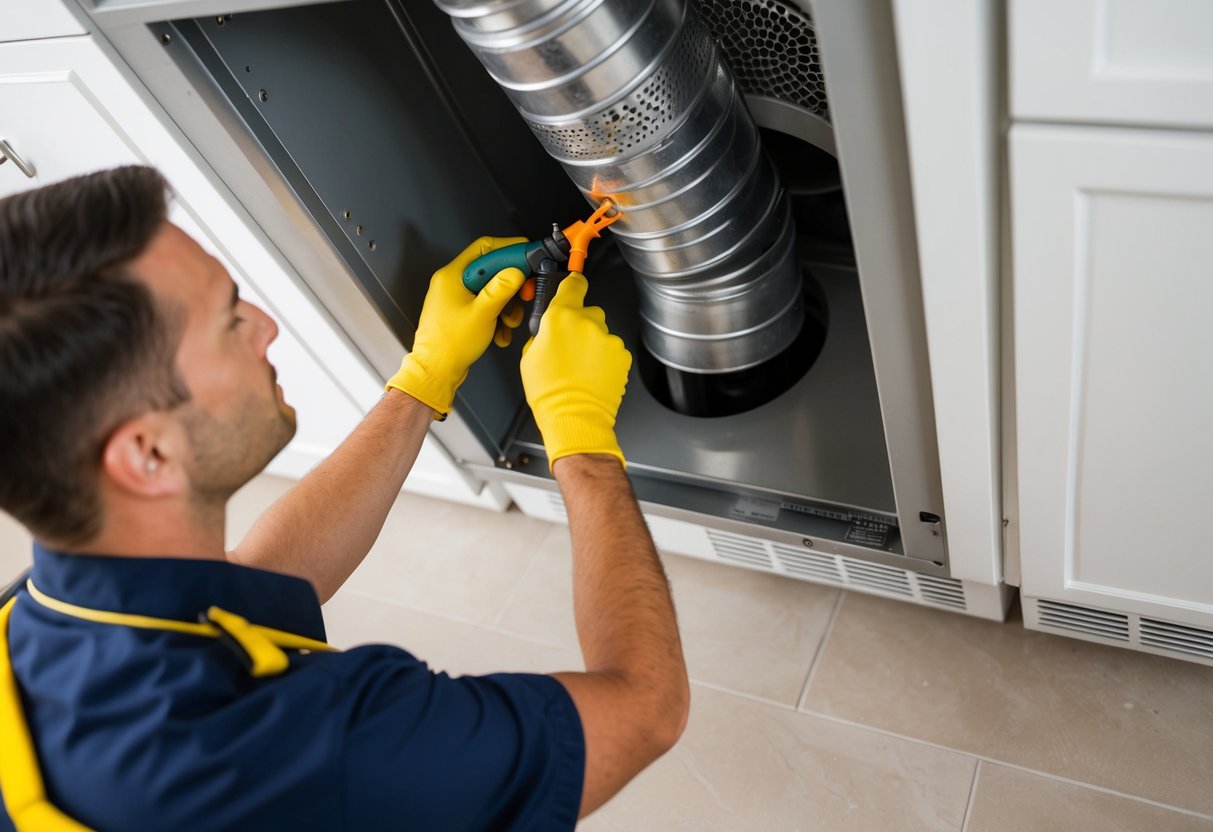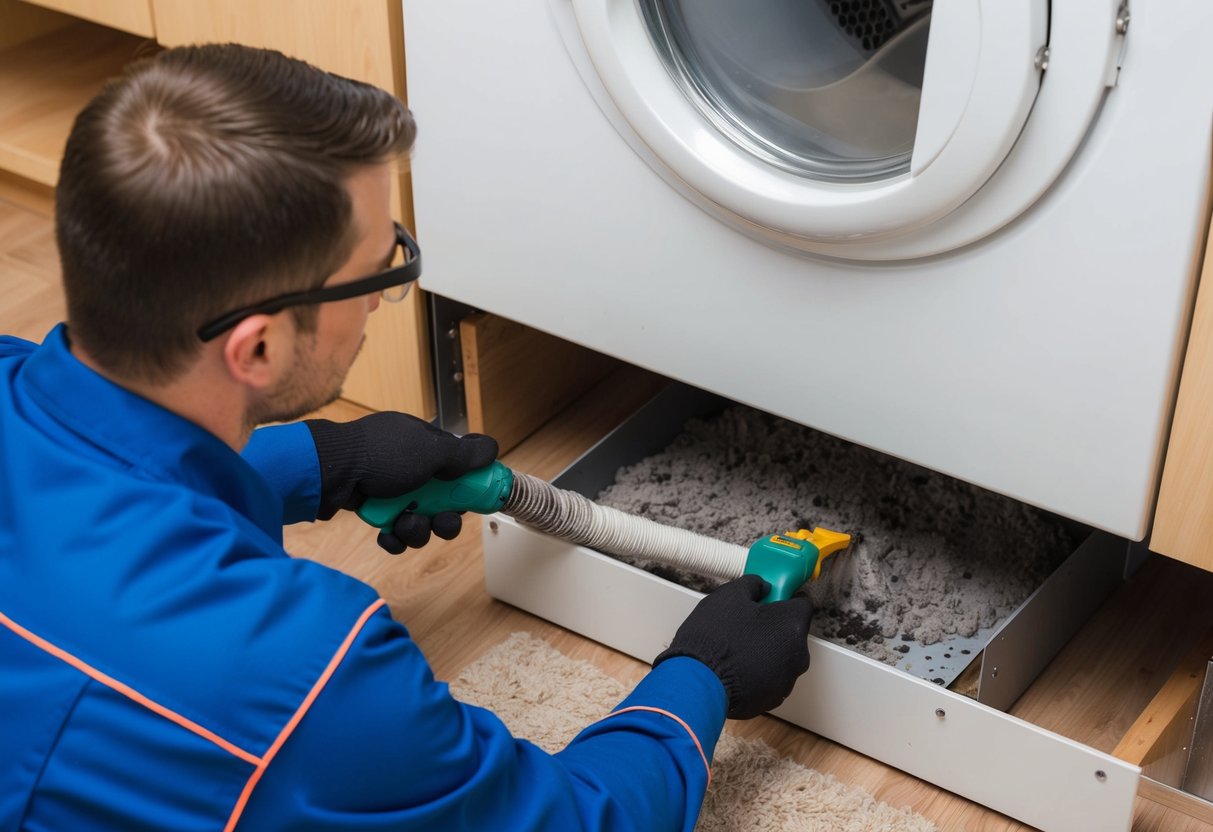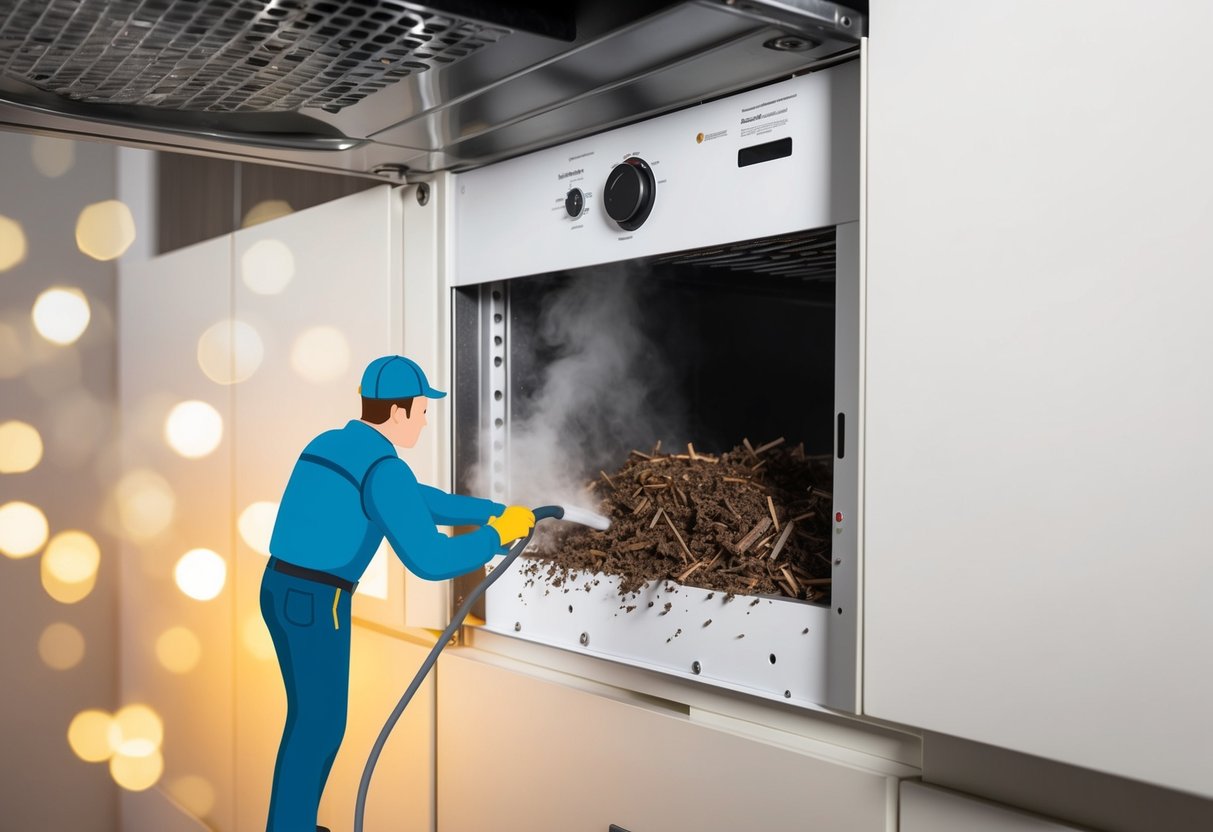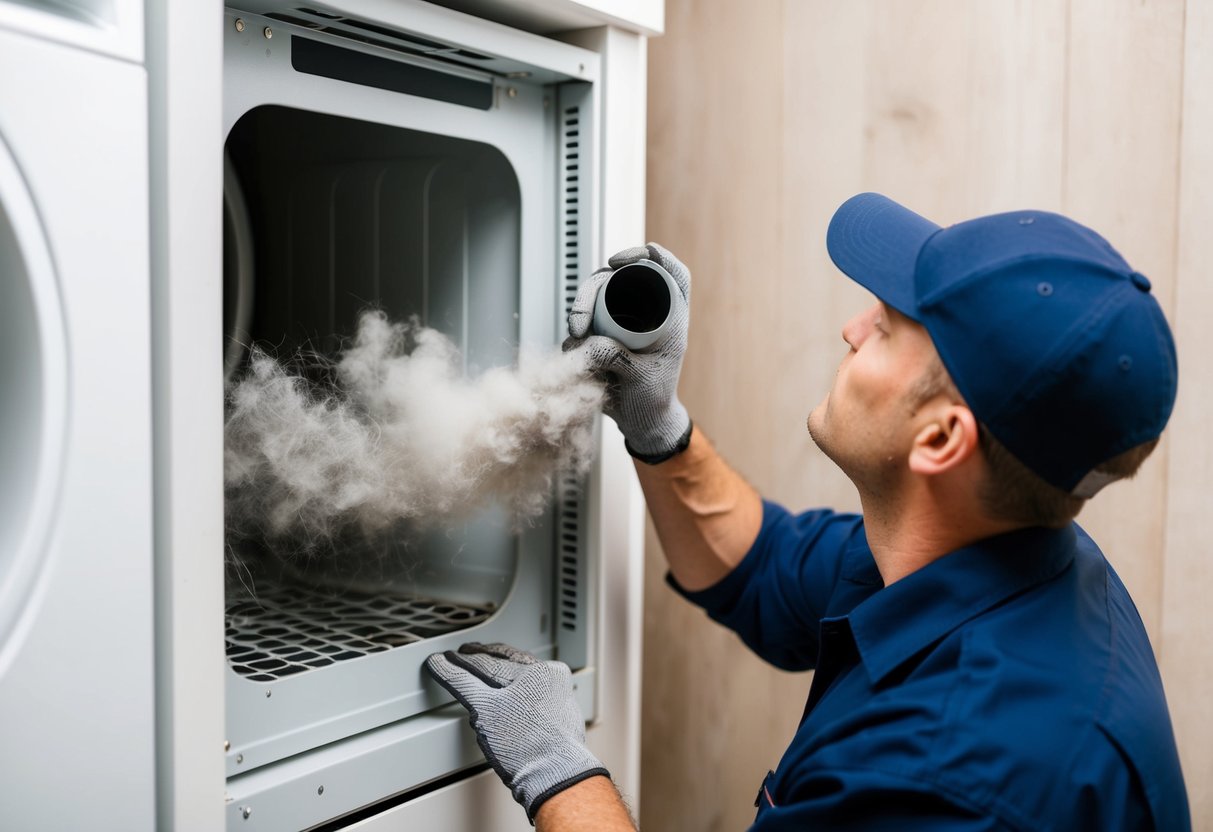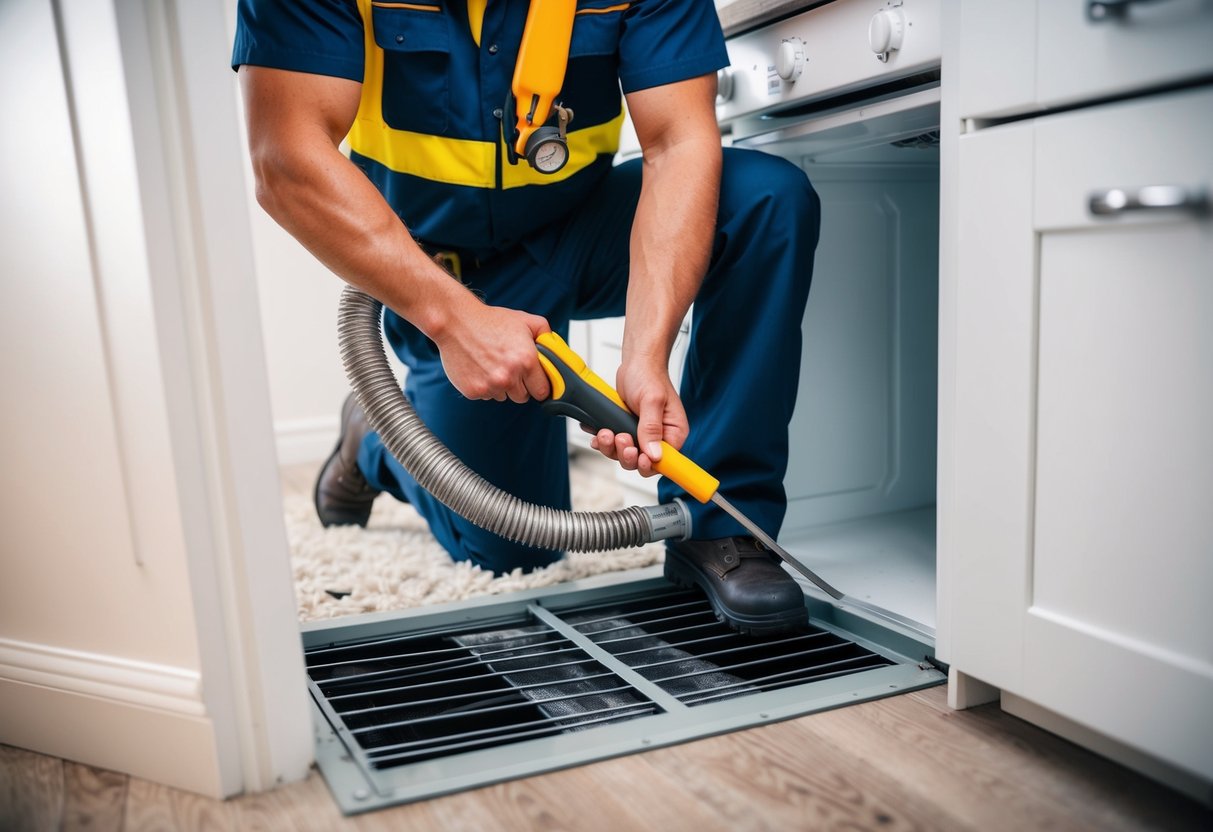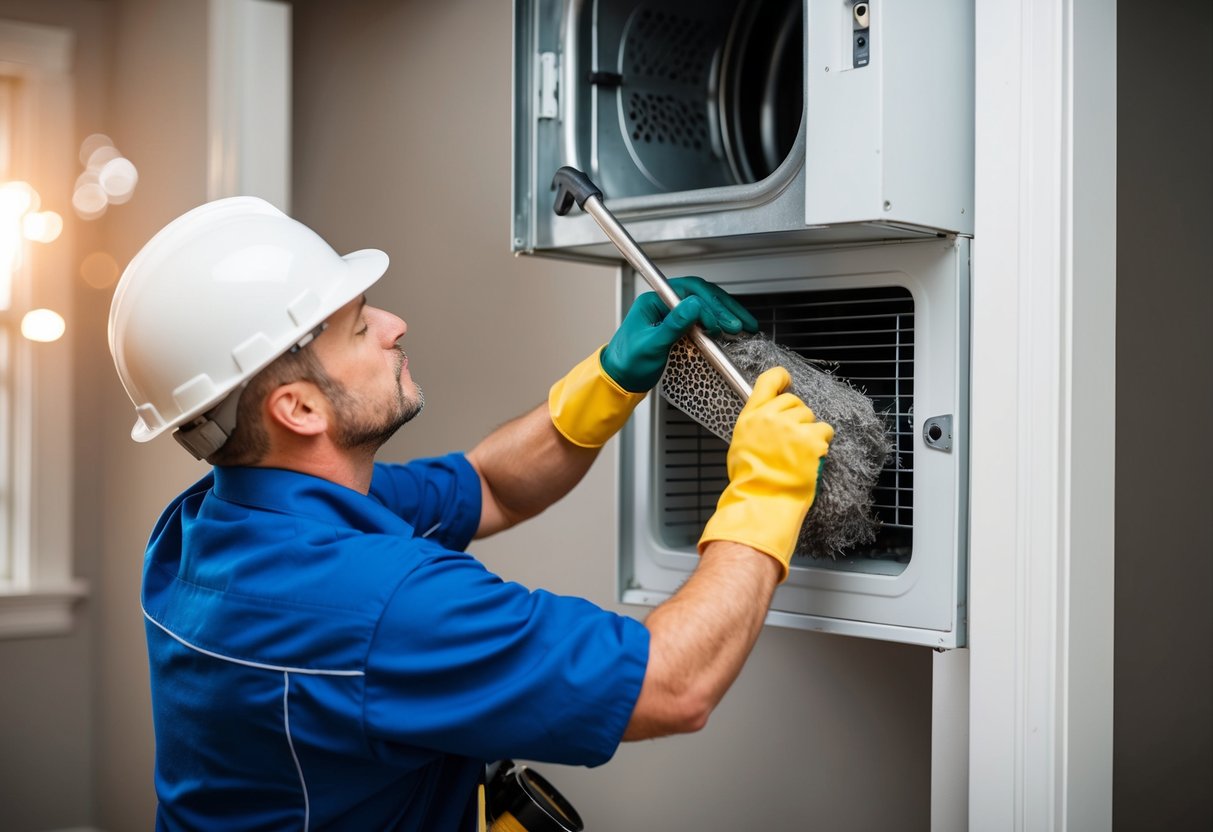Introduction
Dryer vent maintenance is a critical aspect of home safety that often goes overlooked. Neglected vents can lead to serious fire hazards, putting your property and loved ones at risk. Regular cleaning and repair of dryer vents can significantly reduce the chances of a home fire, improve appliance efficiency, and extend the lifespan of your dryer.
Proper dryer vent cleaning involves more than just emptying the lint trap after each use. It requires thorough inspection and cleaning of the entire vent system, from the dryer to the exterior outlet. This process removes lint buildup, debris, and potential blockages that can cause overheating and ignite flammable materials.
Understanding the importance of dryer vent maintenance empowers homeowners to take proactive steps in preventing fire hazards. By implementing a regular cleaning schedule and addressing repairs promptly, individuals can ensure their homes remain safe and their appliances function optimally.
Key Takeaways
- Regular dryer vent cleaning reduces fire risks and improves appliance efficiency
- Signs of clogged vents include longer drying times and excessive heat
- Professional maintenance ensures thorough cleaning and identifies potential hazards
Understanding Dryer Vents and Fire Risks
Dryer vents play a crucial role in home safety. They remove hot, moist air and lint from clothes dryers, but can become fire hazards if not properly maintained.
Components of a Dryer Vent System
A typical dryer vent system consists of several key parts:
- Lint trap: Captures loose fibers and debris from clothes
- Ductwork: Channels hot air and lint away from the dryer
- Exhaust hood: Allows air to exit the home while preventing pests from entering
The lint trap is the first line of defense against lint buildup. It should be cleaned after every load. Ductwork can be rigid or flexible, with rigid metal ducts being the safest option.
Proper installation is critical. Vents should be as short and straight as possible to minimize bends where lint can accumulate. Regular professional maintenance ensures optimal performance and safety.
How Lint Build-Up Can Lead to Hazards
Lint accumulation in dryer vents poses serious fire risks. As lint collects, it restricts airflow and causes the dryer to work harder. This can lead to overheating and potentially ignite the highly flammable lint.
Key dangers of lint buildup include:
- Reduced dryer efficiency
- Increased energy consumption
- Potential for carbon monoxide buildup in gas dryers
- Heightened risk of fire
The U.S. Fire Administration reports that failure to clean dryer vents is a leading cause of home fires. Regular cleaning and inspection are essential to prevent these hazards.
To minimize risks, homeowners should clean lint traps after each use, periodically vacuum the dryer’s interior, and schedule annual professional vent cleanings. These simple steps can significantly reduce the likelihood of dryer-related fires.
Signs of a Clogged or Damaged Vent
Recognizing the indicators of a problematic dryer vent is crucial for maintaining appliance efficiency and home safety. These signs manifest through visual cues, performance issues, and sensory warnings that should not be ignored.
Visual Indicators and Performance Issues
Extended drying times are a telltale sign of a clogged vent. Clothes may remain damp after a full cycle, indicating reduced airflow.
Excessive lint accumulation around the dryer or vent opening suggests a blockage. Regular cleaning of the lint trap may not suffice if the vent is clogged.
A dryer that feels unusually hot to the touch during operation could signal poor ventilation. This overheating can strain the appliance and pose fire risks.
Visible damage to the vent pipe, such as kinks or separation at joints, can impede proper exhaust flow. Inspect the exterior vent cover for obstructions or debris buildup.
Sensory Warnings of Vent Problems
A burning smell during dryer operation is an alarming sign. It may indicate lint buildup that’s overheating or even catching fire within the vent.
Unusual sounds like rattling or whistling from the vent area can suggest partial blockages or loose connections. These noises often occur when airflow is restricted.
A musty odor emanating from freshly dried clothes might indicate mold growth in a damp, poorly vented system. Proper ventilation prevents moisture accumulation and subsequent mold issues.
Regular Maintenance for Safety and Efficiency
Proper dryer vent maintenance is crucial for preventing fire hazards and ensuring optimal appliance performance. Regular cleaning and inspection routines can significantly reduce risks while improving energy efficiency.
Benefits of Cleaning the Lint Trap and Vent
Cleaning your dryer vent regularly offers numerous advantages. A clean lint trap allows for better airflow, reducing drying times and energy consumption. This simple practice can lead to substantial savings on utility bills over time.
Removing lint buildup from the vent system prevents potential fire hazards. Clogged dryer vents are a leading cause of house fires, making regular cleaning essential for home safety.
Clean vents also extend the lifespan of your dryer. When airflow is unrestricted, the appliance doesn’t have to work as hard, reducing wear and tear on components.
Establishing Routine Inspections
Setting up a regular inspection schedule is key to maintaining a safe and efficient dryer system. Homeowners should check their dryer vents at least once a year, or more frequently for high-usage households.
During inspections, look for signs of blockages such as:
- Longer drying times
- Clothes feeling unusually hot after a cycle
- Excessive heat in the laundry room
- Burning smells when the dryer is running
Professional inspections can identify issues that may not be visible to the untrained eye. Experts can assess the entire vent system, including areas behind walls or in crawl spaces, ensuring comprehensive maintenance and safety.
Professional Versus DIY Vent Care
Dryer vent maintenance involves choosing between professional services and do-it-yourself approaches. Each option has distinct advantages and considerations for homeowners.
When to Call the Experts
Professional dryer vent cleaning offers expertise and peace of mind. Experts have specialized tools to reach deep into vents, ensuring thorough cleaning. They can identify and address potential issues that may not be visible to untrained eyes.
For complex vent systems or those in hard-to-reach areas, professional services are essential. Homeowners with limited mobility or those uncomfortable working with tools should opt for professional help.
Experts can also provide a comprehensive inspection, checking for damage or wear that could lead to future problems. This preventative approach can save money and reduce fire risks in the long run.
DIY Cleaning Techniques and Tools
For those preferring a hands-on approach, DIY dryer vent cleaning is possible with the right tools and techniques. A dryer vent cleaning kit is a valuable investment for homeowners. These kits typically include flexible brushes and extendable rods to remove lint buildup.
A vacuum cleaner with a hose attachment can be effective for cleaning the vent’s exterior opening. Regular cleaning of the lint trap and periodic checks of the vent hose are simple DIY tasks that improve dryer efficiency.
It’s crucial to disconnect the dryer before attempting any cleaning. Homeowners should also be cautious not to damage the vent while cleaning. If unsure about the process or encountering any difficulties, it’s best to consult a professional.
Advanced Repair and Maintenance Strategies
Proper dryer vent maintenance requires specialized techniques to address complex issues and optimize system performance. These strategies focus on resolving stubborn blockages and upgrading components for enhanced safety and efficiency.
Dealing with Complex Clogs and Blockages
Professional dryer vent cleaning is crucial for tackling severe blockages. Experts use specialized tools like rotary brushes and high-powered vacuums to remove stubborn lint buildup and debris. These tools can reach deep into the vent system, ensuring thorough cleaning.
For hard-to-reach clogs, technicians may employ snake cameras to identify and locate blockages. This allows for targeted removal without damaging the vent structure. In extreme cases, partial disassembly of the vent may be necessary to access and clear the obstruction.
Regular inspections can prevent complex clogs from forming. Homeowners should watch for signs like longer drying times or excessive heat, which may indicate a developing blockage.
Replacing Parts and Upgrading the System
Dryer vent repair often involves replacing worn or damaged components. Common replacements include:
- Vent covers
- Flexible transition ducts
- Rigid metal ductwork sections
Upgrading to a more efficient system can improve safety and performance. Consider installing:
- Lint alert systems to monitor airflow
- Secondary lint traps for added protection
- Booster fans for long vent runs
Rerouting the vent system may be necessary if the current layout is inefficient or poses safety risks. This can involve shortening the vent run or relocating the exit point to improve airflow and reduce fire hazards.
Always consult a professional for complex repairs or system upgrades to ensure compliance with local building codes and manufacturer specifications.
Frequently Asked Questions
Dryer vent maintenance and safety are crucial for preventing fire hazards in homes. Understanding proper usage, cleaning techniques, and risk factors can significantly reduce the likelihood of dryer-related fires.
How can overloading a dryer contribute to potential fire risks?
Overloading a dryer can lead to inadequate airflow and heat distribution. This causes clothes to remain damp, increasing drying time and putting extra strain on the machine.
Excess lint production from overloaded loads can quickly clog vents and filters. Blocked vents can cause lint buildup, potentially leading to fire hazards.
What are effective strategies to prevent dryer fires?
Regular maintenance is key to preventing dryer fires. Clean the lint trap after every load to ensure proper airflow and reduce lint accumulation.
Schedule annual professional dryer vent cleanings to remove built-up lint from the entire vent system. Install a bird guard on the exterior vent to prevent nesting animals from blocking the vent.
What steps are involved in cleaning a dryer vent to minimize fire hazards?
Start by unplugging the dryer and removing the lint screen. Clean the screen thoroughly with soap and water if needed.
Use a vacuum cleaner with a long hose attachment to remove lint from the interior venting system. For thorough cleaning, disconnect the vent from the dryer and wall to access the entire vent length.
Does homeowners insurance typically cover damage from dryer vent fires?
Most standard homeowners insurance policies cover fire damage, including fires caused by dryer vents. However, coverage may be limited if the fire resulted from neglect or improper maintenance.
It’s essential to review your specific policy and consult with your insurance provider for detailed coverage information. Regular dryer maintenance can help ensure your claim is not denied due to negligence.
What proportion of residential fires are attributed to issues with dryer vents?
Dryer vent fires account for a significant portion of residential fires in the United States. According to the U.S. Fire Administration, clothes dryers are responsible for approximately 2,900 home fires each year.
Of these dryer-related fires, failure to clean the dryer vent is the leading cause, accounting for about 34% of incidents.
At what point does a lint-clogged dryer vent become a significant fire hazard?
A dryer vent becomes a significant fire hazard when lint accumulation restricts airflow and causes the dryer to overheat. This can occur gradually over time, but noticeable signs include longer drying times and clothes feeling unusually hot after a cycle.
Experts recommend cleaning dryer vents at least once a year to prevent dangerous lint buildup. More frequent cleaning may be necessary for households with high dryer usage or long vent ducts.

